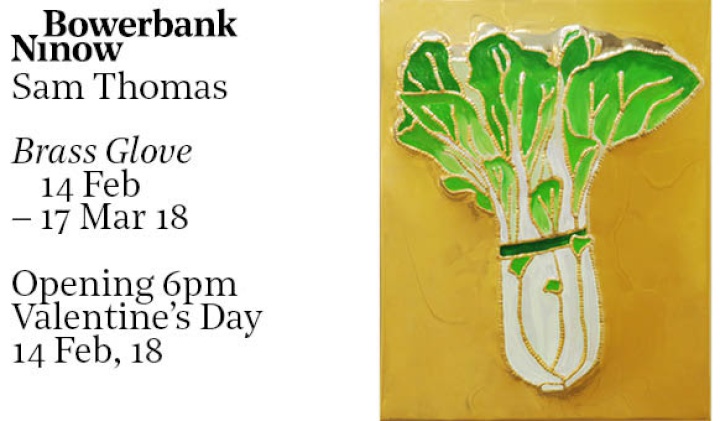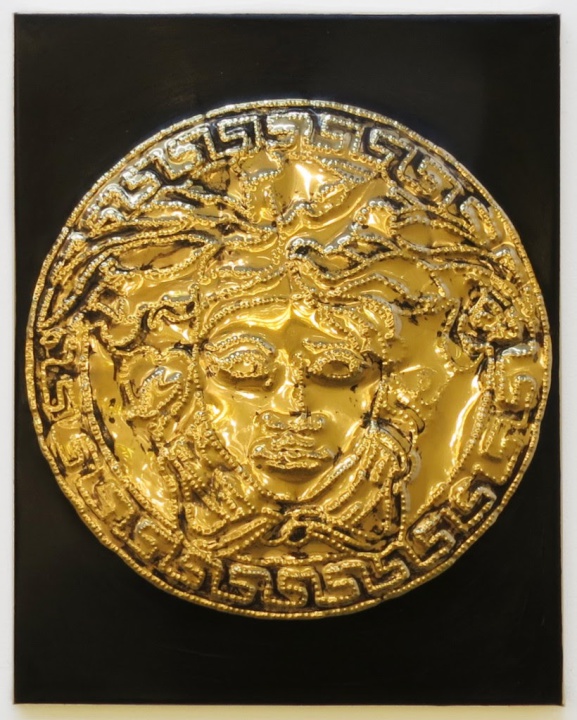Bowerbank Ninow: Sam Thomas - Brass Glove
Bowerbank Ninow: Sam Thomas’ Brass Glove

Sam Thomas’ Brass
Glove is a continuation of the artist’s series of
repoussé, or embossed, paintings. These works comment on
the art object as a receptacle for value and status, but
their eclectic figurative content suggests a network of
personal connections and ideas percolating beneath their
reflective surfaces.
Thomas’ work is both
materially and conceptually related to the idea of
plasticity. Repoussé is neither an additive nor a
subtractive process; rather, it exploits the ductility of
metals—their ability to stretch and change shape while
retaining their original volume. In art, language is as
often a hindrance as a help, and has the ability to stretch
and distort a meaning just as Thomas’ metal punches and
hammers reshape a metal sheet. Like jokes, some artworks are
best appreciated in the moment, seen whole and unmediated,
without the intermediary voice of the critic or the artist
themselves intervening to direct a potential
response.
For Thomas, the process of titling works
and shows is one of iteration and progression, tempered by a
constant awareness of the distortions that language can
inflict on works of art. During the production of Brass
Glove, Thomas experimented with several titles for this
group of works, and examining the ones he tried and
discarded may help to shed light on his thinking around the
relationship of language to his work.
Thomas’ initial thought was to title the show Diptych diptych, and to pair the works; in this way, he found that “by stringing them together they gained different significance, as words do in a sentence.” That Thomas chooses to deploy a linguistic analogy in this context is no accident. His work lends itself to narrative comparisons and constructions, and often develops a single idea over several works or groups of works. In this sense, the works seem to develop a flexible grammar of their own, generating new potentialities through their interactions with one another.

Versace Moon (Full),
2017
oil on brass
450mm x 350mm
The next iteration in the titling process was the idea of artificial intelligence—conceptualised as a synthetic process of information gathering. In this framework, Thomas would place the artworks themselves as informational nodes: “It occurred to me that the very first form of artificial intelligence could in fact be art works, as they're made by people and each one possesses valuable information.” The idea of artworks as “intelligences” is suggestive in the context of Thomas’ choice of subject matter. The images he chooses—fruits, vegetables, logos, faces framed as though by phone camera snaps—are in a sense void of meaning, empty vessels waiting to be filled by our desires and fantasies like the smooth, blandly accessible icons of an emoji keyboard. However, Thomas seems to suggest that these kinds of devalued symbolic systems might also contain vestiges of their own obscure purposes and meanings.
The penultimate evolution of the show’s
title was Bootleg, a phrase that suggests, in
Thomas’ view, the idea of “kitsch-ness, like faked or
stolen artefacts that could be bought in bulk at a roadside
tourist store.” The idea of the object as a “fake” is
intriguing; in a contemporary image-making context, where
everything is infinitely replicable and replaceable, the
status of the original is problematised. This title also
suggests a connection to the body, a literal item of
clothing that would draw the viewer back towards a more
visceral interaction with the work.
Ultimately, readdressing the work’s physicality was what led Thomas to his final title, Brass Glove. The idea of a glove is multivalent in this context, suggesting both a container or protective sheath for a complex tool (the hand), and also a trace of that same body, vanished but still present. A glove is a bounded absence, waiting to be animated by an exterior agency or intelligence—but perhaps also possessed of some intrinsic memory of its own.


 GPNZ: Extended Skill Mix In Primary Care Teams Improves Patient Access And Outcomes
GPNZ: Extended Skill Mix In Primary Care Teams Improves Patient Access And Outcomes New Zealand Symphony Orchestra: Music Legend To Conduct Bach, Beethoven And Mozart With NZSO
New Zealand Symphony Orchestra: Music Legend To Conduct Bach, Beethoven And Mozart With NZSO Ministry of Health: Ministry Of Health To Look Further At Waikato Hospital Event
Ministry of Health: Ministry Of Health To Look Further At Waikato Hospital Event Emirates Team NZ: Statement From Emirates Team NZ On Auckland Hosting Of 38th America’s Cup
Emirates Team NZ: Statement From Emirates Team NZ On Auckland Hosting Of 38th America’s Cup PPTA Te Wehengarua: Draft English Curriculum Lacks Connection With Reality
PPTA Te Wehengarua: Draft English Curriculum Lacks Connection With Reality Oratia Books: Revised Edition Of Much-praised History Examines The Great War Experience Of New Zealand, Australia And Canada
Oratia Books: Revised Edition Of Much-praised History Examines The Great War Experience Of New Zealand, Australia And Canada